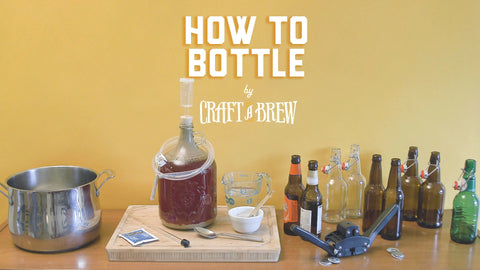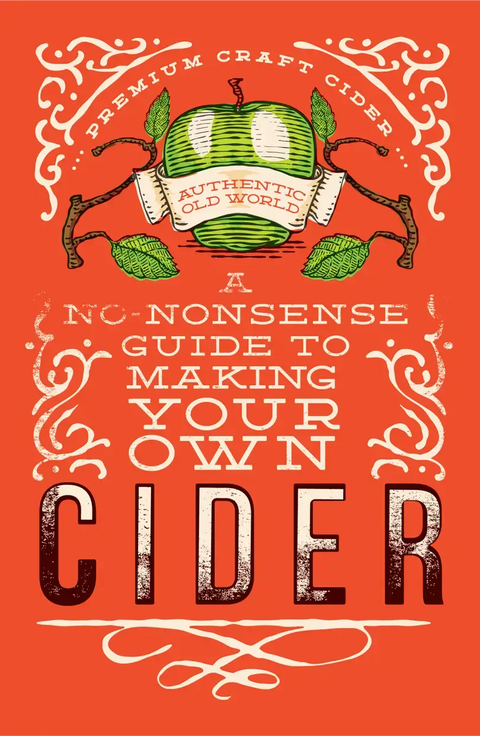Making Hard Cider - FAQ
If you don’t see your question answered here, shoot us an email at support@craftabrew.com! DO NOT discard anything until you are able to connect with our team - we can help you save your cider!
Hard Cider Kit basics
Our Hard Cider Kit includes ingredients to make THREE 1 gallon batches. A gallon of cider will fill eight 16oz bottles or ten 12oz bottles.
You’ll need to source a gallon of apple juice for each batch. You’ll also need bottles for carbonating your hard cider.
Your homemade hard cider will finish between 5-6% ABV (alcohol by volume). The precise ABV may vary slightly depending on the sugar content of the juice or cider base you use. The best way to determine your cider’s exact ABV is with a hydrometer.
You can use apple juice or apple cider - just be sure to use 100% juice that’s DOES NOT CONTAIN PRESERVATIVES. Ascorbic Acid is okay, but if you see Potassium Sorbate or Sodium Benzoate listed as ingredients on the bottle your cider won’t be able to ferment. For a clearer hard cider, apple juice is best. For a hazy, unfiltered hard cider, a cider base is best.
You can make hard cider from your own pressed/juiced apples, though we might recommend using store-bought for a smooth first fermentation & to get a hang of the process if you’re making your very first batch. Different types of apples (like Granny Smith) may prove to be a little more tart, other apples may vary in flavor vs. standardized store-bought juice, but the natural sugar in juiced apples from home should be enough to properly ferment. Just make sure you have as close to a gallon as possible when you add the yeast - the raised text “ONE GALLON” on our carboy is the 1 gallon fill line.
Don’t worry - it can be improved! Low carbonation levels usually means that the yeast simply needs some more time to create CO2. If you’ve moved all bottles from your batch into the fridge, bring them out and let them stand at room temperature for another 3-5 days before chilling a bottle & testing again. Weak carbonation can also be caused by: too much headspace in bottles, carbonating in too cold an environment, not using enough priming sugar or having an improperly sealed cap. For future brews, try our pre-measured Priming Sugar packs or Carbonation Drops.
Yep! Sediment is to be expected in any naturally fermented beverage. Any yeast that is suspended in the seltzer will eventually settle to the bottom of the bottle during carbonation. You can avoid getting this into your glass by pouring slowly and leaving the last ounce in the bottom of the bottle. There is no perfect way to remove all of the sediment unless you use a professional style filter, but getting the sediment into your glass will not hurt anything except the appearance.
We recommend enjoying your homemade hard cider within 6 months of refrigerating it for the best flavors.
Customizing Your Hard Cider
Our Hard Cider Kit isn’t just for apple juice! You can incorporate other fruit juices to make flavored hard ciders. We do recommend using at least a 50% apple juice base (0.5 gallon) to guarantee enough fermentable sugars for the yeast. Try half tart cherry juice or half pear juice or whatever your favorite flavor is. Citrus juice is NOT recommended because it’s quite acidic and the sugar content can be a bit low. So steer clear of orange, lemon, lime or grapefruit juices.
Yes you can! If adding fruit to your cider, be sure to add less than a full gallon of juice to your carboy (adjust the juice volume accordingly per the amount of fruit you plan to add). Blend a few peaches, a few handfuls of berries, or whichever fruit you like until the fruit becomes a thin puree, add water if necessary. Strain this mixture through a cheesecloth or fine mesh strainer. Boil for 5 minutes, let cool and add directly to the carboy. Top off with more apple juice as needed to reach the one gallon fill line. Proceed with fermentation and bottling as usual.
Our Hard Cider Kit will yield a 5-6% ABV batch of cider. The finished ABV is determined by the fermentable sugars present before you add your yeast. More sugar = more “food” for the yeast.
You can boost ABV by 0.5% by dissolving 1.5 oz of white table sugar in water on the stove. Let cool to room temp or below. Add with apple juice before pitching the yeast. NOTE: Pushing the ABV too far can have negative impacts on the flavor & mouthfeel. So, we don’t recommend increasing the ABV by more than 2%.
Our Hard Cider Kit produces a traditional dry hard cider, so the finished flavor won’t be apple-y sweet. As with wines and meads, a hard cider won’t taste quite like the fruit or juice does before fermentation.
Adding sugar to your fermenter won't make the cider sweeter. In fact, the sugar will be converted into alcohol and may further dry out the finished cider.
To sweeten your hard cider, you can use a non-fermentable sugar, like Xylitol, Erythritol or even Lactose or Maltodextrin (which are less sweet). These sugars can't be fermented by yeast, so the sweetness remains in the cider.
Fermentation Questions
Your hard cider should sufficiently ferment in 10 days as long as the fermentation temperature is within range (60-75ºF).
If temperatures are on the cooler side, this can slow down the fermentation, meaning it takes more than 10 days for the yeast to do its job and you’ll continue to see activity in the airlock. In this case, you should try relocating the fermenter to a warmer spot &/or insulating the fermenter with a towel or sweater. Let your cider continue to ferment until airlock activity has stopped.
If the temperature is not a factor & if the bubbles in the airlock are spaced out (maybe 1 bubble every 30 seconds or more), then this could simply be diffused CO2 being released. In this case, fermentation is likely complete, but CO2 that’s dissolved into the cider is slowly beginning to release itself. In this case, your cider is okay to bottle.
Bottling & Carbonation Questions
You’ll need roughly ten 12oz bottles (or eight 16oz bottles). We have a variety of Bottling Kits that are perfect for your Hard Cider. You can also re-use or recycle bottles from beer or cider you drink at home. We like Grolsch beer bottles, which are flip-top style and don’t require caps or a capper tool. OR you can reuse pry-off bottles with our Capping Kit, which includes bottle caps & a capper tool.
Don’t worry - it can be improved! Low carbonation levels usually means that the yeast simply needs some more time to create CO2. If you’ve moved all bottles from your batch into the fridge, bring them out and let them stand at room temperature for another 3-5 days before chilling a bottle & testing again. Weak carbonation can also be caused by: too much headspace in bottles, carbonating in too cold an environment, not using enough priming sugar or having an improperly sealed cap. For future brews, try our pre-measured Priming Sugar packs or Carbonation Drops.
Yep! Sediment is to be expected in any naturally fermented beverage. Any yeast that is suspended in the cider will eventually settle to the bottom of the bottle during carbonation. You can avoid getting this into your glass by pouring slowly and leaving the last ounce in the bottom of the bottle. There is no perfect way to remove all of the sediment unless you use a professional style filter, but getting the sediment into your glass will not hurt anything except the appearance.
We recommend enjoying your homemade hard cider within 6 months of refrigerating it for the best flavors.
If you prefer a still, uncarbonated cider, you can skip the priming sugar addition on bottling day. We still recommend bottling your hard cider. This helps separate cider from sediment and helps prevent oxidation during storage. Leaving the cider in the carboy with its sediment well beyond the fermentation process can result in unwanted off flavors
Instead of allowing bottles to carbonate for 10 days at room temp, you'll instead refrigerate the bottles immediately.
Our Guide To Making Hard Cider
User friendly instructions for making Hard Cider. Includes recipe ideas for making fruity or spiced cider.
If you’re still stumped or don’t see your question answered above - email us at support@craftabrew.com. Don’t dump anything until we’ve connected. Including photos in your email will help us help you more efficiently.




